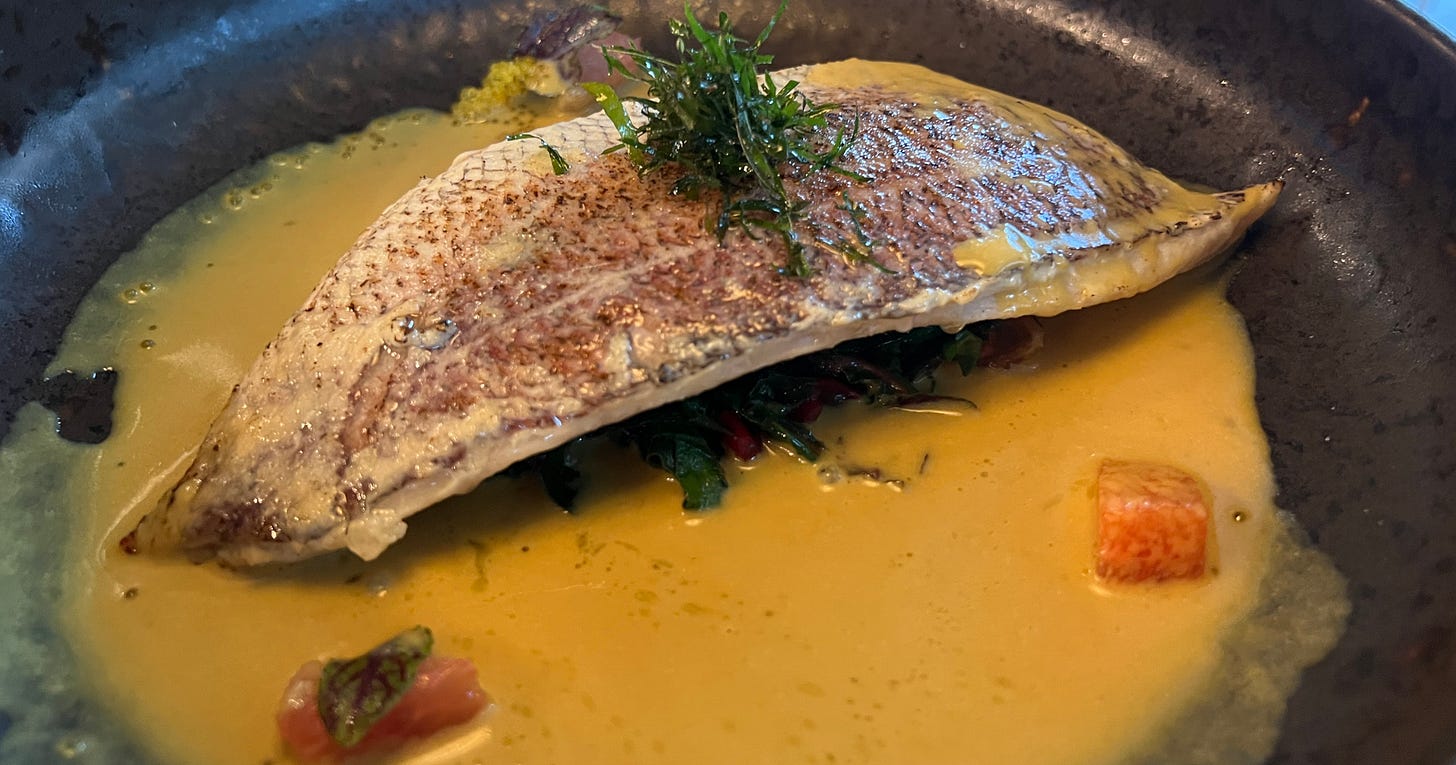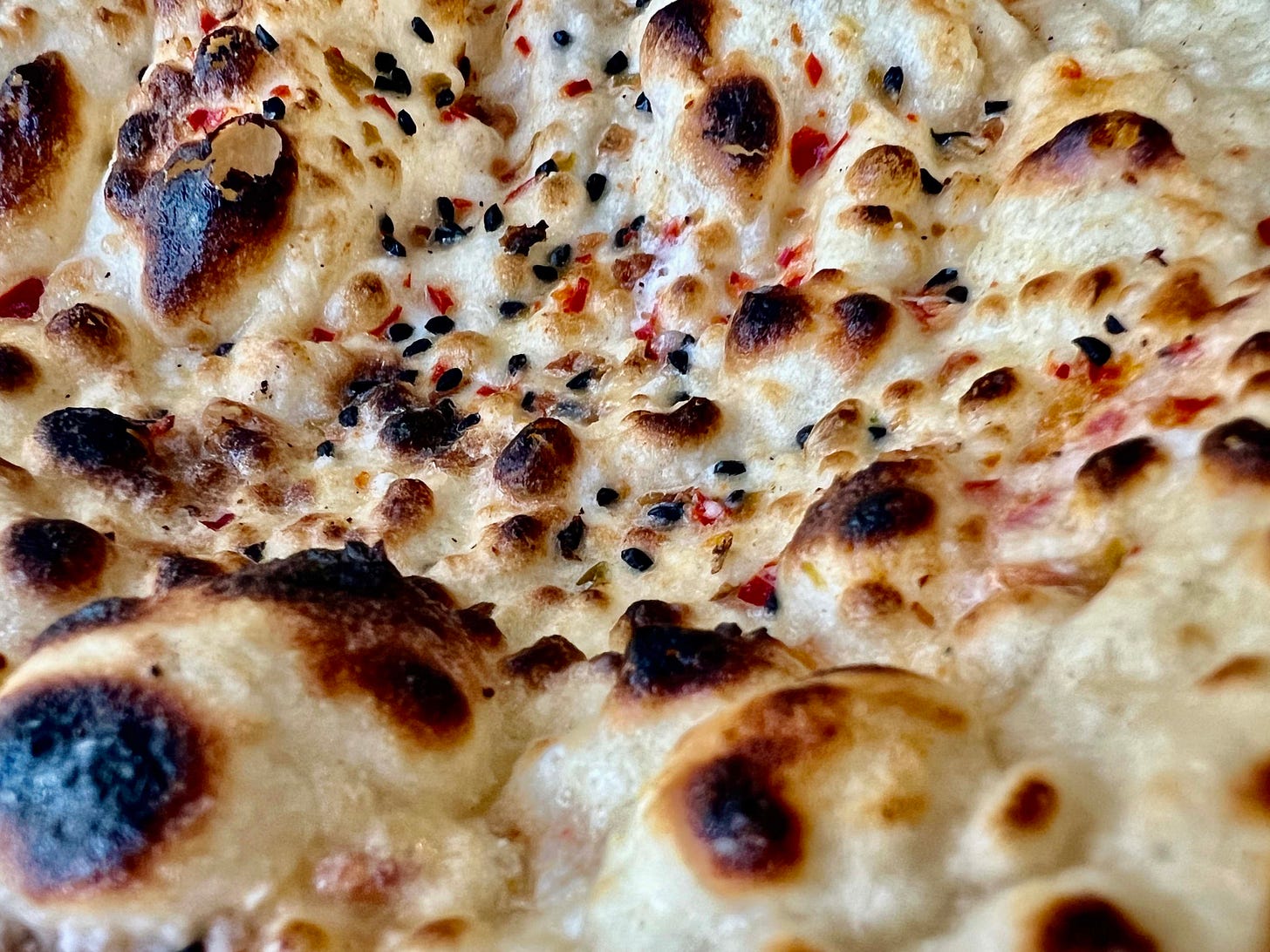It was a gorgeous meal, an expensive meal, and I learned something new, to me at least. Less than a week ago Donna Campbell and I happened to be in the Park District of North Hills, a Raleigh neighborhood that feels more like Alexandria, Virginia these days--high rise, high-end housing, glittering office buildings, a torrent of March wind weaving through concrete corridors, walls glowing golden at sunset. Every other storefront seemed to be a new restaurant. Five o’clock dog walkers and fast moving couples were already on the sidewalks, some heading to the gym, others to one of the many corner bars.
We’d read about the “modern Indian” fare at a restaurant called Tamasha, a word which means show or a spectacle in Hindi. Just one year into this venture, Bhavin Chhatwani has been named a James Beard semifinalist in the category of Emerging Chef. So with fingers crossed, we called in a reservation and soon snagged a cushy booth. The restaurant is gilded, small, and elegant. They even have a dress code.
We started with the Crispy Okra and Tuk Aloo Chaat—a flash-fried tower of mandolined okra strips studded with pomegranate seeds and fluffed rice. Underneath, tastes of tamarind and mint swirled atop a foundation of roasted potatoes. Fabulous finger food.
Next, we tried the Collard Green Tidaali Dal (how could we not?) made with three different lentil varieties and served with simple pancakes. Amazing.
Then we shared the tender yellow tail snapper, oh-so-slow cooked in a sauce of green mango, coconut milk, curry leaves, and grapefruit festooned on a bed of Swiss chard. I never had better snapper ever--a subtle collaboration of flavors.
To the side, however, came another revelation--the “Nigella Seeds Chilly Olive Naan”—a paper thin, crispy grilled bread dotted with red chili flakes and jet black nigella seeds. For a gardener in the US South, nigella seed usually means Nigella damascene or “Love in A Mist”—a hardy, cool blooming annual in the ranunculus or “buttercup” family. I planted some of those seeds last year, acquired at a gift shop in the Old City Cemetery in Lynchburg, Virginia--a botanical destination famous for its antique rose collection. Nigella damascene seeds can be and are sometimes used as a condiment. but only in limited quantities because but they have some toxic properties.
But these nigella seeds on the Tamasha naan were something quite different.
It turns out that these aromatic, wedge-shaped seeds, bigger than a poppy but smaller than a caraway, are from a plant called Nigella sativa, native to Eastern Europe and Western Asia. They are sometimes called black cumin, though they are not cumin. The scent is reminiscent of cumin, but with a little something else, more toward oregano and stronger. They are also called black onion seeds or black caraway, also completely inaccurate. In India the name is Kalonji or charnushka seeds, which is how I found them labeled at a Durham spice shop.
Some sources recommend dry roasting the whole seeds in a hot pan to bring out the flavor. Others recommend using ghee (clarified butter) to roast and release their depths. Then sprinkle in moderation. I tried some in scrambled eggs, and I found that less is more. They pair well with citrus. I can also imagine them on a salad or topping a bowl of hearty beans.
Nigella seeds reportedly keep their flavor for a year if sealed tight. They are popular in Bengalese recipes, especially in a spice mix called “panch phoron,” which means five spices, usually nigella, fenugreek, cumin, brown mustard, and fennel seeds. In the Middle East nigella seed is often used to flavor cheeses such as haloumi. References to these seeds go back to the Old Testament.
Historically treasured for its medicinal properties, Nigella sativa can also be processed into an herbal oil that has been used through the ages as a natural remedy for inflammation, high blood pressure, back pain, and headaches. The oil was found in King Tut’s tomb and revered in ancient Egypt. It can be applied topically, and is sometimes added to massage oils and shampoos, according to Oliver Farm Artisan Oils—a Food Pilgrim destination in Georgia that we plan to visit later this year. Stay tuned! Meanwhile, thank you, Tamasha, for the lesson in flavors!








Great article and I can smell the spices! Hope to try this restaurant.
Me, three! This place sounds amazing.